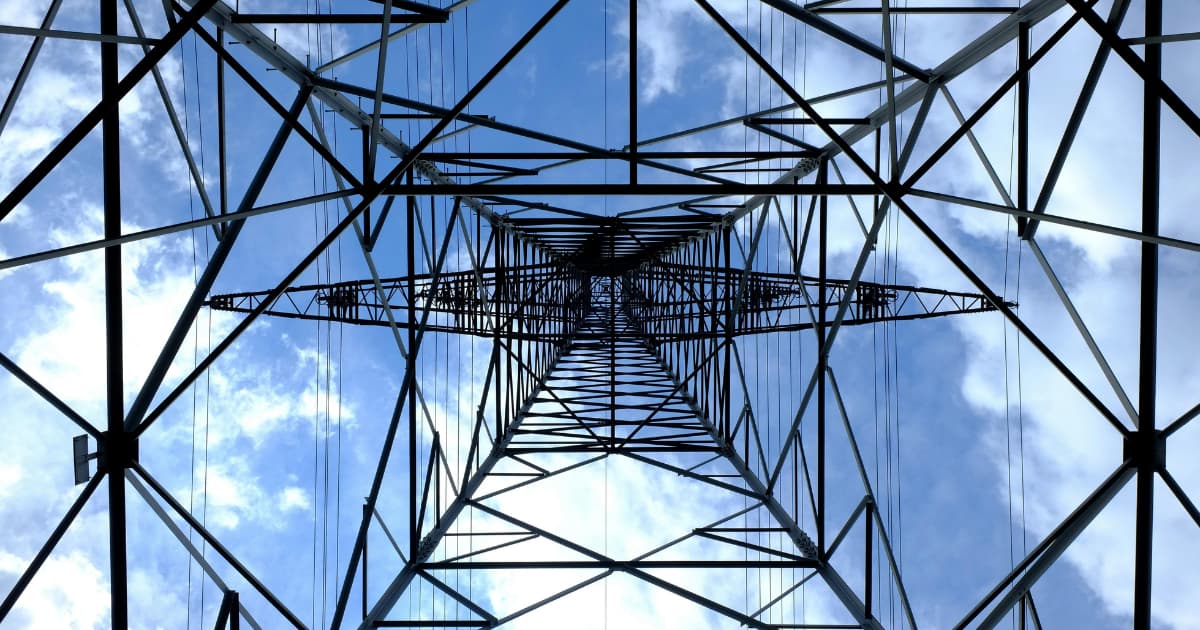Utility companies providing essential services such as electricity, water, and gas are critical to our daily lives. Failures in service provision leads to adverse effects, impacting communities’ health and financial well-being.
Dwindling resources, population increase, and adverse weather patterns are some of the challenges facing utility companies. However, evolving technological capabilities are changing how utility companies serve communities.
With AI at the center of this transformation, studies show exponential growth in its adoption across the utility provision landscape. For instance, the global AI market size in the energy industry was valued at $4 billion in 2021. However, forecasts put it at $19.8 billion by 2031, growing at a CAGR of 17.4%(2022-2031)1.
Essentially, AI helps utility companies improve their processes and workflows. By leveraging data, these companies can meet high customer expectations, increase productivity, and save costs.
This article delves into the integration of AI and utility service provision. We explore how AI affects the energy, water, internet, and even waste management sectors. We also look at real-world AI use cases in the essential utilities industry.
The Power of AI in Utilities
AI-based tools are set to help utility companies optimize resource management and provision. With end users expecting better services, utility providers can thrive by integrating AI into different workflows.
Smarter grids for electricity distribution
Power distribution systems have also taken advantage of rapid advancements in computational power, AI, and big data. Additionally, there’s an increase in the harmonious integration of cyber and physical components due to the growth in distributed energy resources(DER) and the Internet of Things(IoT).
Demand response management
Energy consumption during peak times puts energy infrastructure under great strain. AI-enhanced demand response helps power companies adjust energy consumption in real-time, depending on demand and supply.
Due to the complexity of the problem, ML and DL algorithms such as regression and hybrid long-term short-term(LSTM) neural networks can provide valuable insights. These algorithms can analyze data from buildings using points like occupancy rates, historical energy consumption patterns, and weather to determine and manage energy demands.
Electricity companies can plan demand management programs to avoid blackouts and strains on the infrastructure. The strategy can focus on the demand side, using price signals to incentivize users to shift their usage during peak times.
About 10.3 million customers in the US have been enrolled in demand response programs, with 97% in the residential sector2. This program has the potential to help providers save money and defer the construction of new power plants and related distribution systems3.
Predictive maintenance
Reactive and time-based power distribution system maintenance is less effective than predictive maintenance. A study by Deloitte quantified the impact of predictive maintenance4:
- 5%-20% increase in labor productivity
- 3%-5% decrease in new equipment costs
- 5%-15% reduction in facility downtime
AI-powered predictive maintenance uses advanced modeling techniques to determine and predict equipment failure.
Multiple ML and DL algorithms can be used to develop predictive models. Examples include random forest, YOLO, gradient boosting, K-Means, convolution neural network(CNN), and LSTM recurrent neural network5.
Integrating sensors, smart meters, and other smart grid devices on assets like transformers and distribution lines makes it possible to gather data in real-time. This means that the condition of an asset can be determined in a live ecosystem. AI-based solutions sift through the data, provide insights, and alert teams when certain thresholds are met.
Using AI to build robust predictive solutions helps in the early detection of anomalies and their cause analysis. This helps improve worker safety, avoid costly power disruptions, and prolong asset lifespan. Additionally, workers can perform targeted repairs and replacements.
One of the largest electric companies in the US, serving over 7 million customers, deployed an ML-powered predictive maintenance solution. The goal was to monitor asset health and predict asset failure in advance. The solution was capable of monitoring 10,000 transformers and 22,000 circuit breakers.
AI helped the company reduce transformer failure by 48%, helping save $800,000 annually. The proactive model also optimized asset maintenance and replacement, lowering costs and boosting productivity6.
The State Grid Corporation of China(SGCC), serving over 1.1 billion customers, has put AI-enhanced predictive maintenance to great use. This includes:
- Analyzing data from customers’ smart meters to identify potential problems
- Tracking thermal conditions of transformers to detect overheating issues
- Monitoring power line vibrations to detect problems before they cause power outages
Grid stability
Energy grids continue to face a myriad of challenges, such as the incorporation of renewable energy and increased adoption of electric vehicles(EVs). ML models can analyze weather data, energy demands, grid performance, and power supply to optimize distribution. Grid operators can use these insights to determine and predict how much energy is required in the short-medium term and how to dispatch it cost-effectively7.
With ML solutions, power distribution companies can balance power loads, reduce grid congestion, detect anomalies, and enhance efficiency.
For instance, the use of EVs is mostly localized within cities, which can overwhelm local grids. However, companies like WeaveGrid provide integration solutions powered by AI8. By using ML to study charging patterns, they determine the optimal charging times and make recommendations to users, reducing strains on grids.
Managing renewable energy integration
James Kelloway, Energy Intelligence Manager at National Grid ESO, indicates that AI can accurately predict the performance of renewables. This gives them more control over other power plants like those based on coal that take time to ramp up electricity production9.
AI is a powerful tool that renewable power developers use to forecast power generation. Energy traders can use these insights to predict their output and accurately bid in the wholesale power market.
IBM provided self-learning weather models for the Sunshot initiative. The model used historical and real-time weather data for solar forecasting. The projects saw a 30% increase in solar forecasting accuracy, which led to improved solar power utilization and decreased operational electricity generation costs.
Customer service
Power utility companies serve millions of customers, and using customer service can be underwhelming. In an interview, Abhay Gupta, Co-founder and CEO at Bidgely, an AI-based company that works with utility companies, intimates that utilities have to do a better job personalizing communication with their customers. He adds that they must utilize the troves of data they have to achieve this10.
Using generative AI, chatbots can generate human-like responses that are context-aware, especially when trained on custom data. The chatbot can provide relevant information based on customer input.
AI can elevate customers’ experience, helping utility companies save costs, improve service provision, and identify opportunities.
AI in transforming water supply management
Water utility companies distribute water to demand points, which forms a complex network of interconnected systems with different functions. AI and other digital technologies can help water utility companies get better insights and improve service delivery. Sensor technologies and smart meters can provide data to AI models, providing a way to monitor and better manage water distribution networks.
Leak detection
Non-revenue water, primarily through leaks, is a common problem facing water utility companies. AI-based systems can be trained to detect abnormal water flows that represent leaks. Using artificial neural network(ANN) models, a detection system can forecast real-time failure events by processing pressure and water flow data from sensors11.
Algorithms like fuzzy inference systems and bayesian networks can be applied to check differences between the expected and real-time flow rates. They can indicate confidence levels, which raise alarms when certain thresholds are met12.
Such systems can also learn from historical data to predict future ones. AI-based leakage systems help reduce false positives, save costs, and reduce water loss.
A large UK water utility company uses an AI-powered event detection system to help detect failures in its network. The solution processes data from 7000 sensors near real-time to help detect leakage and pipe bursts. Additionally, the solution can alert the operators of possible pipe failures by pinpointing events that precede these failures.
Through AI pressure optimization, Cape Town saves about €300,000 annually in operations and maintenance costs. The solution resulted in a 58% reduction in pipe bursts and a 38% reduction in water leaks13.
Automated asset management
A report by Bluefield Research indicates that better asset management can save water utility companies upwards of $41 billion(2018-2027) in capital expenditure14.
It’s possible to leverage ML techniques using pipe characteristics, GIS information, population data, and soil information. Additionally, combining such data with historical records and real-time data greatly helps AI models detect patterns, giving the status of water infrastructure.
ML algorithms, such as the bayesian network, can predict the vulnerable parts of the water distribution network. The solution can infer the probability of a pipe failure using available data. This can have different confidence levels, which can help operators proactively manage assets.
Smart asset management using AI primarily helps extend infrastructure lifespan and reduce repairs and maintenance costs.
Water demand management
Accurate forecasts of water demands help utility companies reduce costs and energy use. Multiple ML and DL algorithms qualify to build such models, but their effectiveness depends on data availability and the level of depth of the forecasts. Auto-regressive(AR) algorithms, adaptive neuro-fuzzy inference systems, neural networks, and time series models can be used to build such solutions15.
Forecast solutions can accurately predict consumption and demand patterns depending on variables such as time of day, season, and socioeconomic factors. This enables correct estimation of the water needed from reservoirs, helping reduce water loss while meeting needs.
AI-enhanced Gas Pipeline Management
Here are some ways gas utility companies can use AI for better service provision.
Real-time monitoring for leak detection
Gas leakages can lead to fatal consequences, including loss of lives. It’s, therefore, paramount that the integrity of gas distribution networks is without question. Data analytics, IoT, and AI provide advanced ways to monitor and detect leakages proactively.
ML and DL techniques like deep CNN and LSTM can classify gases based on sensor data16. Additional data from acoustic leak detectors and thermal imaging can be analyzed to identify leakages.
Bayesian-based decision modules can process the data to determine the presence or absence of gas leaks. This module can also determine how large the leak is17. With AI-based solutions, pipeline integrity can be monitored continuously. This helps avoid material losses and compliance with safety and regulatory standards.
Safety
Distribution networks, storage facilities, and associated terminals have been built to sustain residential and industrial gas needs. However, these facilities deteriorate over time due to continuous gas corrosion.
Gas leaks may lead to explosions, intoxication, or suffocation, which can endanger human lives and the environment. For instance, reports indicate 2,600 pipeline leaks in the US between 2010 and 2021. These hazardous incidents caused more than $4 billion in damages, and 122 lives lost18.
Manual inspection of the distribution network may not suffice due to multiple complexities, such as inaccessible areas. Other methods leverage mathematical models that analyze data from specialized sensors. However, there can be a boost in the efficiency of detecting unsafe leakages using ML and DL techniques such as neural networks.
Pipeline damages
This occurs primarily due to excavator damages. For instance, in the US, gas pipeline damage by third-party excavators resulted in $1.5 billion in damages. Out of 330,000 damages to utilities, 85,993 impacted natural gas pipelines19.
AI and ML techniques can sift through data to identify the riskiest excavations using historical data and other information like location characteristics and type of work. With these companies receiving many tickets, there’s a critical need to identify and classify the riskiest cases. A solution that ranks risks and predicts impact can be modeled using AI.
Such solutions help gas utility companies avoid costly repairs and threats to public safety.
Intelligent ticket management
The Southern Company Gas, headquartered in Atlanta, serves 4 million customers and receives 2 million tickets annually. With so many incident tickets, it becomes impractical to classify all of them and assess risk appropriately. The company implemented an AI-powered solution to address the issue, ranking tickets depending on the threat posed to their gas distribution infrastructure.
The solution combines the company’s internal data and variables like weather information and contractor history. The company has seen an improvement in the identification of sites that are damage-prone. The solution decreased excavation damage by 30% in several areas20.
AI in Internet Provision
Internet service providers(ISPs) have also adopted AI to improve service provision and enhance customer experience.
Network security
Cybercrime is one of the biggest challenges globally due to the exponential growth in interconnected devices, networks, and systems. Additionally, attack sophistication continues to evolve, and even ISPs are falling victim. For instance, in 2020, Austria’s largest ISP – A1 Telkom, suffered a cyber attack21.
ISPs are the first line of defense regarding cyber security and must protect consumers. AI can help better ISPs’ security posture through autonomous threat detection and response. AI models can continuously monitor traffic to detect anomalies in real-time.
Some of the responsibilities that AI can take on for cyber security include22:
- Risk assessment against known attack vectors using algorithms like K-Means clustering to classify assets depending on their cybersecurity requirements.
- Automated threat identification and assessment using deep learning techniques and recommendation engines
- Automated threat hunting for proactive search of threats and deploying countermeasures
- Attack path modeling to reduce the possibility of attackers taking advantage of vulnerable routes.
Customer service
Poor customer service at 32% is a significant reason consumers cite for stopping the use of services/products from companies23. With ISPs supporting multiple critical infrastructures, businesses, and jobs, customers must constantly get good support. Using natural language processing(NLP), natural language understanding(NLU), and generative AI, chatbots can understand user input and promptly respond via different formats, such as texts and images. These chatbots provide relevant 24/7 support, understanding context and answering basic questions based on user input.
AI can also help with personalization, enhancing customer engagement. Algorithms can conduct behavioral analysis for user profiling, assisting ISPs in offering tailored recommendations to customers.
Network optimization
Using AI for network optimization gives ISPs immense advantages. It ensures faster and more reliable connections. For instance, a suite of AI and ML tools helped Comcast sustain its services in the face of a 60% surge in network traffic demands during the Covid season24.
AI-driven network optimization entails the following25:
- Dynamic routing: ML models can determine the most efficient network path for routing. This ensures that consumers get sustained connections even during spikes in traffic.
- Load balancing: AI can help ISPs distribute network traffic across their infrastructure.
- Bandwidth management: AI can analyze network traffic to determine “leaks”. The solution can help with bandwidth usage, helping maximize capacity, especially in the face of high demands.
AI-powered predictive analytics
ML-based predictive analytics solutions take advantage of data collected from the network. It’s possible to proactively harness equipment data, network data, and call center tickets to deal with issues causing service disruption.
Some of the common problems include wifi-degradation and equipment failure.
Anomaly detection algorithms like K-Means clustering can flag unusual occurrences that might signify equipment failure. For instance, sensors that monitor network equipment may alert operators when temperatures of specific equipment rise beyond a certain threshold.
Time series models may also allow operators to anticipate equipment breakdown depending on historical data, their use, and real-time data. This helps ISPs avoid downtimes and save costs on unplanned repairs.
Verizon uses an AI-powered predictive analytics platform that automatically monitors 3GB of data per second. The platform monitors millions of network interfaces, including customer routers and sensors in charge of monitoring temperatures. The company can track and mitigate events that could impact customer service. Before, the company relied on customer feedback and complaints before taking action, which was ineffective26.
Waste management optimization
Efficient waste management has become an essential part of modern life. Improper handling of waste leads to pollution, which impacts people’s health and the environment.
AI is transforming waste management processes, from transportation to recycling. Stakeholders bank on AI’s ability to uncover insights to drive more efficiency.
AI applications in sorting and processing recyclables
Solid waste includes packaging, food, clothing, electronics, and other materials. In smart waste management systems, smart sensors, hyperspectral, and visual cameras are paired with AI for smart sorting.27
Other applications sort garbage by color, size, and material. Smart robots can accurately identify the type of waste, sort and separate it. This happens in real-time, helping waste companies improve productivity and boost safety among workers. Reviews show that AI-powered sorting systems can operate with an efficiency of up to 99%.28
ML and DL algorithms like ANN and deep CNN can be used in these automated waste sorting systems to classify waste.
Using hybrid or multi-layered models, it’s possible to tune AI models to determine whether materials are recyclable or otherwise. This reduces the need for manual labor to classify and segregate waste.29
Optimizing trash collection
A lot of trash is generated daily, with countries like the US generating up to 290 million tons of municipal waste annually30. It’s, therefore, imperative to find efficient ways to collect waste efficiently.
Route optimization for the waste collection fleet: According to UNEP, trash collection accounts for 50%-80% of solid waste collection costs in middle-income countries31. Using AI can boost route optimization and reduce the distance for collection by 36.8%. Genetic algorithms(GA) help optimize route constraints such as traffic direction, road inclinations, and U-turns32.
Collection frequency: Using GIS data, the number of vehicles and locations can help determine the waste collection frequency. Algorithms like multiple linear regression and ANN can forecast the waste collection frequency across different locations.
AI-enhanced sewerage management
Sewerage management serves to treat wastewater to reduce pollutants. AI can be used for different purposes, including predictive maintenance of wastewater pipes, water quality monitoring, and evaluation.
Wastewater treatment plants have found multiple applications for AI, including33:
- Models for simulation, prediction, and optimization of pollutant elimination from wastewater
- Wastewater pumping stations to reduce electricity consumption
- Predicting the removal of conventional pollutants
- Optimization for removal of organic micropollutants using ANN and response surface methodology techniques
The state of Arizona launched a pilot program using AI for enhanced wastewater monitoring. According to the assistant water services director, Nazario Prieto, the AI-powered solution will add continuous monitoring to their sewerage system34.
Challenges and considerations
Numerous challenges face the use of AI in utility companies. This is especially true for public utility companies, with many facing budget constraints, understaffing, and old legacy systems.
Cybersecurity
According to reports, the energy sector experienced the brunt of cyber security incidences at 39%. In the incidents studied, supervisory control and data acquisition systems(SCADA), popular for power systems, were targeted at 53%35.
Also, many AI solutions are deployed to the cloud, with reports putting it at 70%36. A recent study shows that 39% of businesses suffered a cloud-based data breach37. There would be dire consequences if AI models deployed in the cloud were compromised.
For instance, if a model that supports gas management is breached, the results may be catastrophic. To mitigate these risks, there is a need for proper cybersecurity measures like hardening the entire infrastructure supporting the AI solution. It’s also paramount to deploy fail-safe measures as a fallback plan.
Costs
The resources needed for AI projects will primarily depend on their complexity. However, initial costs are typically high, with estimates putting large-scale projects costs between $500,000 – $9,000,000.
Working around the high costs of AI projects will need innovation. Projects can be undertaken in a modular fashion depending on funds availability. Public utility companies must also educate their investors on the value of AI.
Ethical considerations
There are numerous ethical challenges that relate to AI automation. For instance, an AI solution may display bias and unfairness based on race, gender, and socioeconomic status. This primarily depends on the data quality used to train the AI model.
It’s, therefore, essential to use broad and diverse data for training and testing to cover all use cases.
Transparency is another concern. Many do not understand how AI-powered systems function. Providing visibility into how systems work boosts user confidence.
Another ethical concern is data privacy and protection. Utility companies hold a lot of personal information, including biodata. Data breaches or incorrect use could lead to the exposure of millions of personal records.
Utility companies that implement AI projects need to safeguard user data. This can be through robust cyber security practices and policies.
Conclusion
Utility companies have found multiple use cases for AI. Advancements in big data, increases in computing power, and the cloud help harness AI’s power.
Among utility providers, energy distribution companies have shown eagerness to adopt AI. Multiple power firms have integrated AI-powered solutions into their workflows for tasks like demand forecasting, predictive analytics, and grid stability. As the world transitions to cleaner energy sources and smarter grids, AI will help push towards a sustainable future.
Other applications include AI-enhanced leak detection solutions that are helping water and gas utility companies avoid material loss. Additionally, AI-powered predictive analytics and demand forecasting solutions assist companies in managing their assets and products better.
However, multiple challenges hinder the adoption of AI solutions in utility companies. The main ones are high project costs, cyber security, and ethical considerations. Promoting transparency, protecting data, and prudent financial management are ways to overcome these barriers.
- AI in Energy Market Size, Share Analysis -2031 | Industry Growth ↩︎
- U.S. electricity demand response customers by sector | Statista ↩︎
- Demand Response | Department of Energy ↩︎
- Predictive maintenance Deloitte’s approach ↩︎
- Deep Dive into Predictive Analytics Models and Algorithms ↩︎
- Predictive Maintenance for Electric Grid ↩︎
- Four ways AI is making the power grid faster and more resilient | MIT Technology Review ↩︎
- WeaveGrid ↩︎
- Why artificial intelligence is a game-changer for renewable energy ↩︎
- AI in the Utility Industry | Utility Dive ↩︎
- Artificial Intelligence Solutions for the Water Sector ↩︎
- Role of AI in water supply management ↩︎
- AI to Optimise Water Distribution Networks ↩︎
- Advanced asset management strategies to drive water utility savings ↩︎
- A Study on Developing an AI-Based Water Demand Prediction and Classification Model for Gurye Intake Station ↩︎
- Gas Detection and Identification Using Multimodal Artificial Intelligence Based Sensor Fusion ↩︎
- Fully automatic AI-based leak detection system – ScienceDirect ↩︎
- New research reveals U.S. gas pipeline leaks have not improved | Reuters ↩︎
- Artificial Intelligence for Natural Gas Utilities: A Primer ↩︎
- Southern Company Gas Damage Prevention – Urbint ↩︎
- Hackers breached A1 Telekom, Austria’s largest ISP | ZDNET ↩︎
- Artificial intelligence for cybersecurity: Literature review and future research directions – ScienceDirect ↩︎
- Customer experience is everything: PwC ↩︎
- How ISPs Used AI and Machine Learning to Manage the COVID-19 Internet Traffic Surge | NCTA ↩︎
- The Role of Artificial Intelligence in Network Management for WISPs and ISPs ↩︎
- The Amazing Ways Verizon Uses AI And Machine Learning To Improve Performance – Forbes ↩︎
- AI-Powered Waste Management System to Revolutionize Recycling | College of Natural Resources News ↩︎
- Artificial intelligence for waste management in smart cities: a review | Environmental Chemistry Letters ↩︎
- How Can AI Help in Waste Management? ↩︎
- AI-Powered Waste Management System to Revolutionize Recycling | College of Natural Resources News ↩︎
- Developing integrated solid waste management plan ↩︎
- How Can AI Help in Waste Management? ↩︎
- Artificial intelligence in wastewater treatment: A data-driven analysis of status and trends – ScienceDirect ↩︎
- Use of AI in water purification and wastewater treatment ↩︎
- Energy sector faces 39% of critical infrastructure attacks | Security Magazine ↩︎
- Cloud based artificial intelligence | Deloitte Insights ↩︎
- 2023 Cloud Security Report Shows Many Data Breaches – Press Release ↩︎







